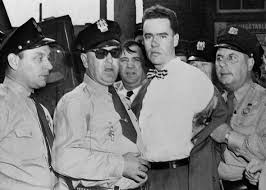On September 6, 1949, something unimaginable happened in Camden, New Jersey. Howard Unruh, a troubled individual, went on a killing spree that changed the course of history. In just 12 minutes, Unruh took the lives of 13 people, leaving behind devastation and sorrow.
The Beginning of Mass Shootings in America
The rise of gun violence and mass shootings in the United States is a grim reality. But when did this dark chapter in American history begin? Some believe it started with Howard Unruh’s actions on that fateful day.
On September 6, 1949, Unruh calmly walked through his hometown, gun in hand, and killed 13 innocent people. This tragic event, known as the “Walk of Death,” is possibly the first mass shooting in American history.
The Troubled Life of Howard Unruh
Unruh’s path to violence was rooted in a troubled life, with signs of his disturbed nature apparent from a young age. Born on January 21, 1921, in Camden, Unruh had developmental delays. He took longer than usual with toilet training and didn’t start walking or talking until he was 16 months old. These details gained attention during his psychiatric evaluation after his arrest.
Despite these early signs, Unruh’s behavior didn’t raise significant concerns. He grew up with his younger brother under the care of their mother, Freda, after their parents separated. Records show Unruh was a shy individual with aspirations of working for the government.
After high school, Unruh joined the Army and served in World War II’s European Theater. It was in combat that signs of his disturbed nature became more apparent. Unruh meticulously documented each German soldier he killed, detailing the circumstances in gruesome detail.
After the war, Unruh’s mental state worsened. Over four gloomy years living with his mother in Camden, he recorded perceived personal slights and devised ways to take revenge on those he believed wronged him.
The Walk of Death
On the evening of September 5, 1949, Unruh prepared for what had consumed his thoughts for years – revenge. The next morning, armed with a German Luger P08 pistol, he began a ruthless killing spree.
Unruh’s first victim was John Pilarchik, a local shoemaker. He then went to a barbershop, where he shot six-year-old Orris Smith and the barber, Clark Hoover. Unruh fired randomly into the streets and a nearby tavern but miraculously didn’t injure anyone inside.
Next, he went to a local drugstore where his main targets, Maurice and Rose Cohen, were. Along the way, he shot an innocent bystander who accidentally bumped into him. In the drugstore, he shot Rose, Maurice’s mother Minnie, and Maurice himself, who tried to escape to the roof.
Unruh continued his rampage, shooting at passing cars and injuring others until he arrived at a tailor shop. Not finding the tailor, he shot his wife and accidentally hit a two-year-old child playing nearby.
By the end of his 12-minute spree, Unruh had killed 12 people and injured four others, marking what could be considered America’s first modern mass shooting.
Howard Unruh’s Last Stand
After unknowingly killing the two-year-old child, Unruh barricaded himself in his home, which the police soon surrounded. Unsure of what to do, the police debated their next steps.
During this time, Philip Buxton, a local newspaper editor, called Unruh out of curiosity. To his surprise, Unruh answered and casually discussed the events. As gunfire erupted in the background, the police decided to act.
With negotiations failing, the police used tear gas to force Unruh out of his home. He surrendered and admitted his guilt.
Life Behind Bars
Unruh’s arrest led to a police investigation, but his confession left no doubt about his responsibility for the massacre. Despite many psychiatric evaluations, the reason behind his actions remained unclear. Unruh acknowledged the wrongfulness of his deeds.
In a chilling interview statement, Unruh expressed remorse, saying, “Murder’s a sin, and I should get the chair.” However, he never faced trial for his crimes.
In 2009, Howard Unruh died in the Trenton Psychiatric Hospital. His final words, “I’d have killed a thousand if I had enough bullets,” reveal the depth of his twisted intentions.
Howard Unruh’s “Walk of Death” is a tragic reminder of America’s dark history of mass shootings. Reflecting on these events, we must address and understand the factors that lead to such violence, striving for a future free from such horrors.
